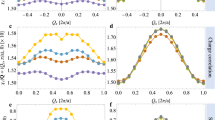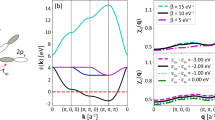Abstract
A model for BaBiO3 was introduced by Rice and Sneddon, which treats this material as a simple three-dimensional version of a Peierls insulator, where the insulating gap is a consequence of the ordered distortion of the oxygen atoms. Charge accumulates on half the atoms and depletes from the other half. Experimentally, when holes are added to BaBiO3 by doping, it remains insulating until a very large hole concentration is reached, at which point it becomes superconducting. In the Rice-Sneddon model, at large enough electron-phonon coupling, a mechanism for insulating behavior of doped samples is formation of small polarons or bipolarons which trap carriers in bound states in the Peierls gap. A variational calculation of the polaron binding in this model is given, and compared with “exact” numerical results on large clusters with periodic boundary conditions.
Similar content being viewed by others
Author information
Authors and Affiliations
Rights and permissions
About this article
Cite this article
Allen, P.B., Kostur, V.N. Polaron defects in a charge density wave: a model for lightly doped BaBiO3 . Zeitschrift für Physik B Condensed Matter 104, 613–618 (1997). https://doi.org/10.1007/s002570050497
Published:
Issue Date:
DOI: https://doi.org/10.1007/s002570050497




